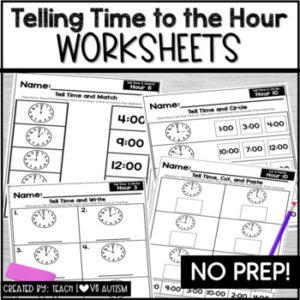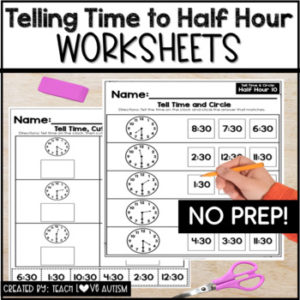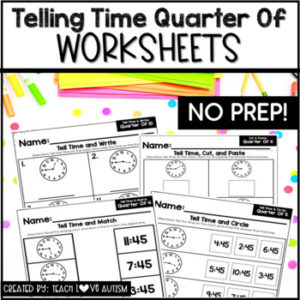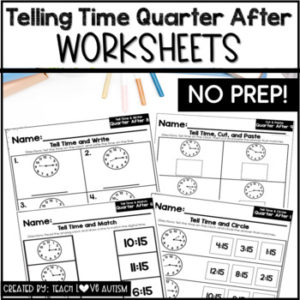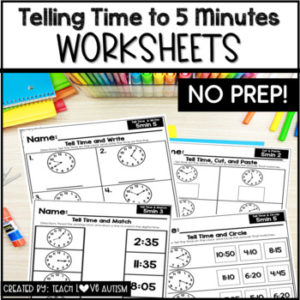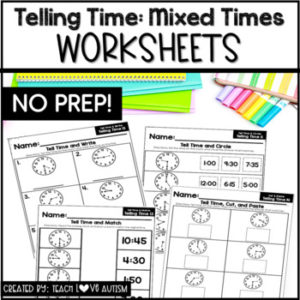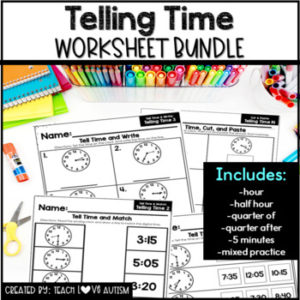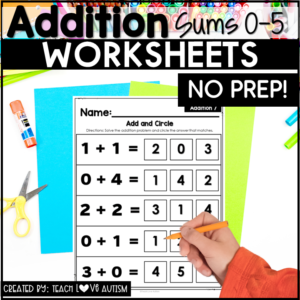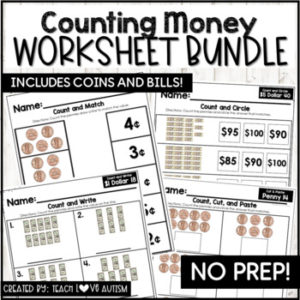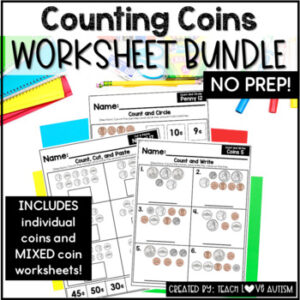Worksheets for Learning to Tell Time to the Hour and More!
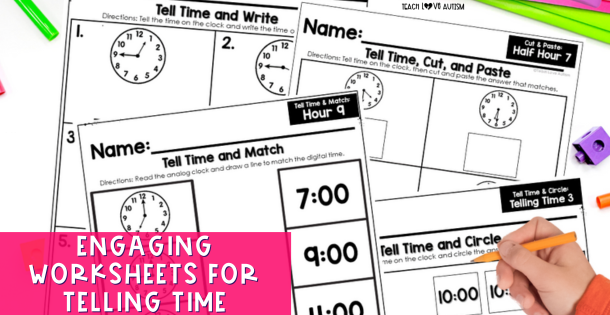
Learning to tell time to the hour and more can be a challenging concept for children, but it doesn’t have to be! With the help of engaging worksheets, the journey of time-telling becomes both educational and enjoyable. In this article, I share how these worksheets can make learning to tell time to the hour and other
Designed for different learning styles, these worksheets provide a hands-on approach to teaching time. By incorporating visual cues, your students are able to grasp the concept of time more easily. Furthermore, interactive activities like matching digital and analog times, drawing lines to match, and cutting and pasting will foster active participation and enhance understanding.
Not only do these worksheets strengthen time-telling skills, but they also cultivate support abilities, such as critical thinking and problem-solving. With a range of worksheet levels, children can progress at their own pace and gradually build a solid foundation in time-telling.
So, whether you’re a parent, teacher, or homeschooling provider, these engaging worksheets are sure to simplify the process of learning to tell time to the hour and more. Get ready to make time-telling a breeze for young learners!
Importance of learning to tell time
Understanding how to read and interpret time is an essential life skill that extends beyond the classroom. From catching the school bus on time to managing daily routines, time-telling plays a significant role in our daily lives. By learning to tell time, children develop the ability to organize their day, effectively manage their time, and be punctual. Additionally, time-telling skills are crucial for other subjects like math and science, where the concept of time is frequently utilized.
Common difficulties in learning time-telling
While time-telling is a fundamental skill, many children struggle with grasping the concept. One common difficulty is understanding the relationship between the hour and minute hands on an analog clock. Children may find it challenging to differentiate between the two hands and comprehend their respective roles in indicating time. Another common hurdle is comprehending the concept of “half past” when telling time to the half hour. The notion of half past can be confusing, and children may struggle to understand how it relates to the position of the minute hand.
The best piece of advice for teaching the two hands on the clock is to teach them first separately and then add them in. I like to focus on teaching to the hour first, and then adding in half hour but using tools to block the other hand until the student has learned it.
Teaching time-telling to the hour
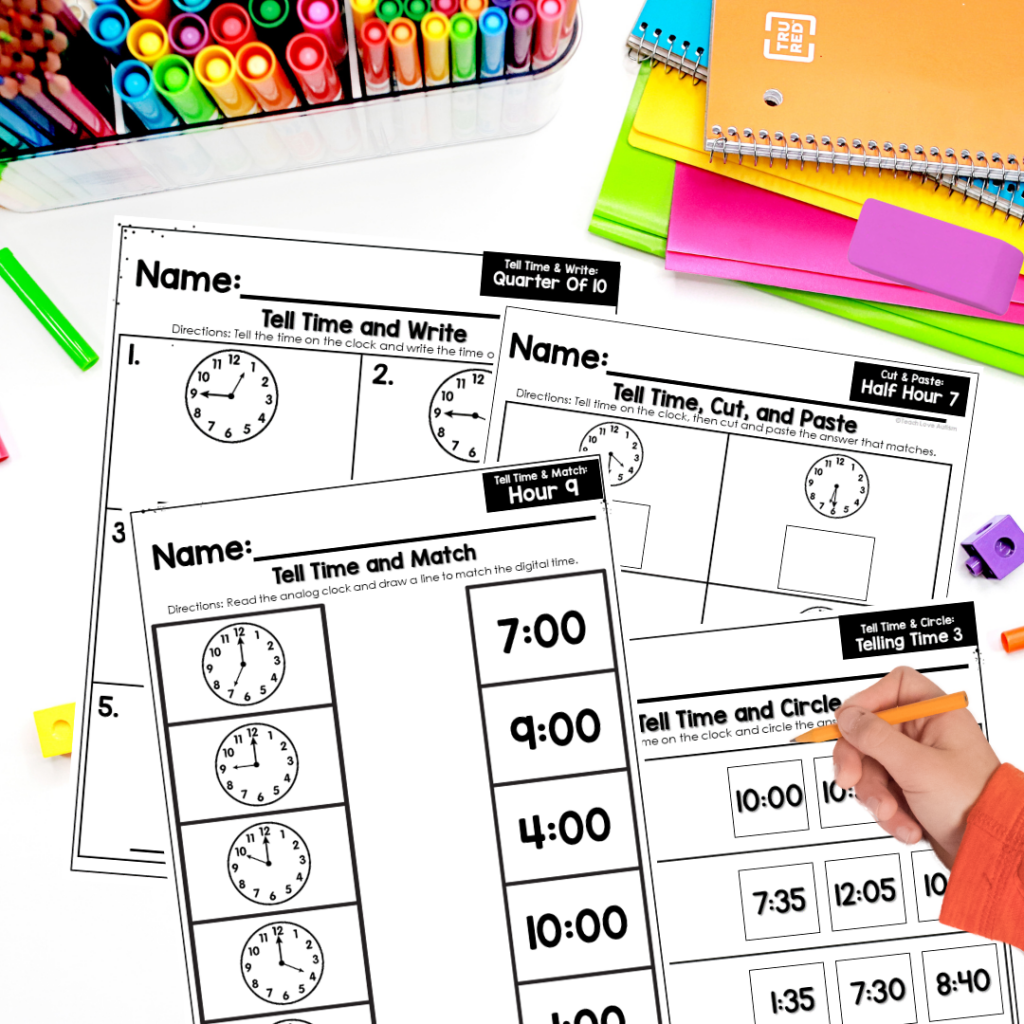
When introducing time-telling to the hour, it is essential to start with the basics. Begin by teaching children how to identify the hour hand on an analog clock and understand its significance. Engaging worksheets that feature clear visuals of clocks with labeled hour and minute hands can aid in this process. Children can practice matching digital and analog times. These interactive activities allow children to actively participate in their learning and reinforce their understanding of time-telling to the hour.
Engaging worksheets for learning to tell time to the hour
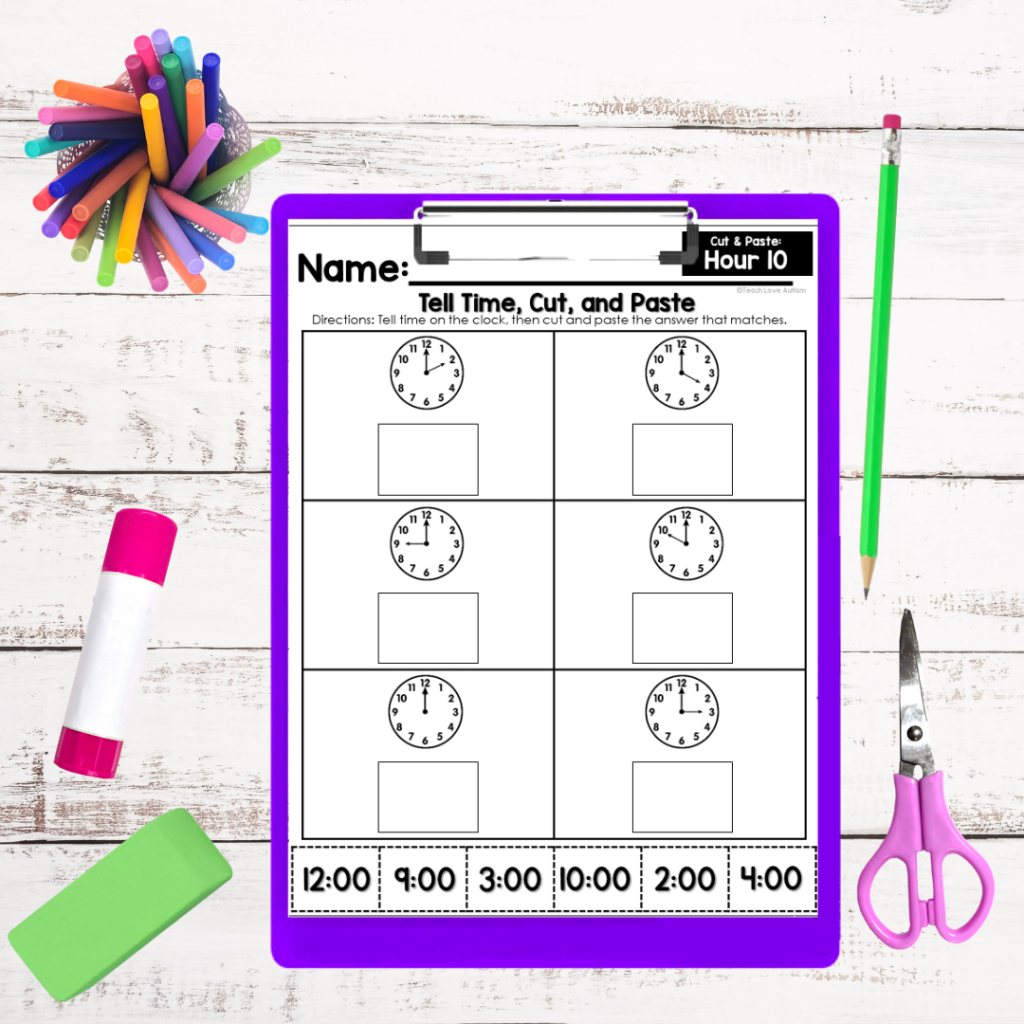
Engaging worksheets for learning to tell time to the hour provide a variety of activities that cater to different learning styles. Some worksheets may include color-coded hour and minute hands, allowing children to easily identify and differentiate between the two. Others may incorporate puzzles and games that require children to match analog and digital times. These hands-on activities not only make time-telling interactive but also reinforce the concept of time in a fun and engaging manner.
Teaching time-telling to the half hour
Once children have mastered time-telling to the hour, the next step is teaching them to tell time to the half hour. This involves understanding the concept of “half past” and how it relates to the position of the minute hand. Engaging worksheets often include visual representations of clocks showing both analog and digital times. Children can practice identifying the position of the minute hand when it is at the half-hour mark and matching it with the corresponding digital time. Additionally, activities like drawing the minute hand on a clock face to indicate a specific half-hour time further reinforce this concept.
Engaging worksheets for learning to tell time to the half hour
Engaging worksheets for learning to tell time to the half hour offer a range of activities that build upon the foundation of time-telling to the hour. These worksheets may include interactive exercises where children have to complete analog clocks by drawing the minute hand at the half-hour position. Other activities may involve solving puzzles or playing games that require children to read and interpret time to the half hour accurately. By providing these engaging worksheets, children can practice and reinforce their time-telling skills in a stimulating and enjoyable manner.
Additional resources for teaching time-telling
In addition to engaging worksheets, there are various resources available to support the teaching of time-telling. Online interactive games and apps provide a fun and interactive way for children to practice their time-telling skills. Educational websites and videos offer instructional materials, including tutorials and practice exercises, to supplement classroom learning. Time-telling books and flashcards provide tangible resources that can be used for individual or group activities. By utilizing these additional resources, you can enhance the learning experience and provide a well-rounded approach to teaching time-telling.
-
Telling Time Worksheets to the Hour$3.00
-
Telling Time Worksheets to the Half Hour$3.00
-
Telling Time Worksheets to Quarter Of$3.00
-
Telling Time Worksheets to Quarter After$3.00
-
Telling Time Worksheets to Five Minutes$3.00
-
Telling Time Worksheets | Mixed Time Practice |$3.00
-
Sale Product on saleTelling Time Worksheet Bundle | Hour | Half-Hour | Quarter After | Mixed Time
$18.00Original price was: $18.00.$14.40Current price is: $14.40.
Tips for using worksheets effectively
To make the most of these engaging worksheets, it is essential to use them effectively. Here are some tips to ensure optimal learning outcomes:
1. Scaffold the learning process by starting with simpler worksheets and gradually increasing the difficulty level as children progress.
2. Provide clear instructions and explanations for each activity to ensure children understand the purpose and objective.
3. Encourage active participation by discussing the concepts and asking open-ended questions during worksheet activities.
4. Provide immediate feedback and praise to reinforce correct answers and address any misconceptions.
5. Incorporate real-life examples and scenarios to help children understand the practical application of time-telling skills.
6. Use a variety of worksheets to cater to different learning styles and preferences.
7. Monitor progress and identify areas that may require additional practice or reinforcement.
By following these tips, educators and parents can use engaging worksheets and facilitate a successful learning experience for children.
Conclusion
Learning to tell time to the hour and half hour can be easy with the help of engaging worksheets. By incorporating visual cues, interactive activities, and a range of difficulty levels, these worksheets simplify the process of time-telling and foster essential cognitive skills. Whether you’re a parent, teacher, or homeschooling provider, these resources are invaluable tools to make time-telling a breeze for young learners. So, get ready to embark on a time-telling adventure and watch as children confidently master this essential life skill.
Looking for more functional concepts to work on with learners? Check out these other worksheets working on money and math facts available in my store!
-
Addition Worksheets Within 5$3.00
-
Sale Product on saleCounting Money Worksheet Bundle
$40.00Original price was: $40.00.$28.00Current price is: $28.00. -
Sale Product on saleCounting Coins Worksheet Bundle
$20.00Original price was: $20.00.$16.00Current price is: $16.00.



